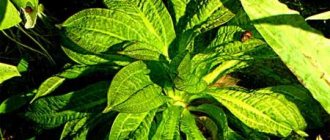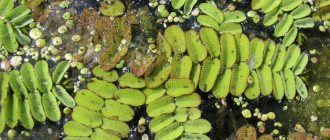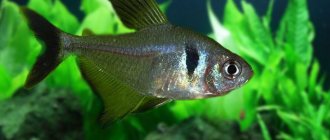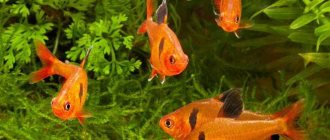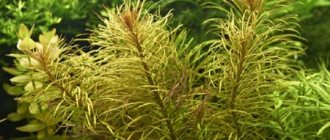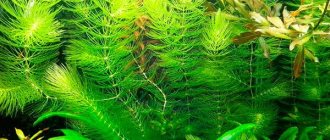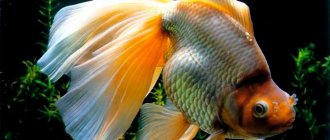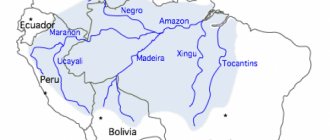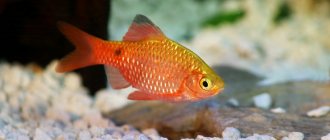Long-leaved hygrophila (Hygrophila spec, longifolia)
The name is given conditionally. The species is not precisely defined. The acanthus family is Acanthaceae. Homeland presumably Southeast Asia.
Long-stemmed plant. In recent years, this species has become increasingly common among aquarists. Thanks to its original shape, the plant looks very beautiful in the aquarium. The leaves arranged in pairs reach a length of 20 cm and a width of about 1.5 cm. The central vein is brown or dark green in color. The plant reaches the surface of the water and comes out into the air, so a high aquarium is needed to keep it. Hygrophila is located at the side walls and in the background. It is relatively undemanding in terms of keeping conditions and grows in an aquarium all year round.
Hygrophila is most suitable for keeping in a tropical aquarium. The optimal temperature is 22 - 26 ° C, but it can be successfully grown at higher temperatures. If the temperature drops below 22 °C, this causes growth to stop. The water should be of medium hardness (at least 8°). The active reaction is neutral or slightly alkaline (pH 7 - 8.5). In soft acidic water, the old leaves of the plant are quickly destroyed. At least once a week it is necessary to change 1/4 - 1/5 of the water volume.
Hygrophila requires very bright lighting. With a lack of light, the size of the leaves decreases and they acquire a yellowish tint. Old leaves are destroyed very quickly. Both natural and artificial light are suitable for lighting. For artificial lighting, incandescent and fluorescent lamps can be used. The power of the latter should be about 0.5 W per 1 liter of water. Illumination with incandescent lamps improves the color of leaves: young leaves acquire a brown tint, the central vein of old leaves retains the same color. The duration of daylight hours should be about 12 hours.
Hygrophila longifolia requires nutritious soil. The root system of this plant is quite developed. It provides basic nutrition to the plant. When planting in new soil, it is advisable to add a little clay, possibly in combination with peat. In the future, natural siltation of the soil is sufficient to ensure the growth of hygrophila. Sand and pebbles of small and medium sizes can be used as a substrate.
Additional fertilizing with minerals is not necessary, since the plant, if properly maintained, receives the necessary nutrition from the soil.
Hygrophila reproduces vegetatively - by cutting the stem and dividing the creeping rhizome. In this case, you should not cut the stem into small pieces, as then the plant develops slowly. It is better to take whole shoots no shorter than 10 - 12 cm.
The plant can be grown in a humid greenhouse, but the leaves become much shorter, become denser, and their color darkens. Like most members of the genus, Hygrophila longifolia grows much faster in the air.
Plant morphology
Hygrophila polyspermous looks like a creeping algae with a long stem. The name of the plant is formed from 2 Greek words: hygros - “wet” and phileo - “love”. The species was described in 1867.
Main characteristics:
- Family - Acanthus.
- Genus - Hygrophila.
- The stem is smooth, 30 to 40 cm long.
- The color of the inflorescences is pale blue. Blooms exclusively in the air.
- The leaves are pointed, up to 8 cm long and up to 1.5 cm wide. They are arranged in pairs, symmetrically opposite each other. Each subsequent pair is formed perpendicular to the previous one. The color of the leaf blade is light green, the reverse side is pale silver.
Hygrophila Polysperma, along with Anubias, is one of the hardy species.
Reddish hygrophila (Hygrophila spec. “Reddish”)
Acanthaceae family – Acanthaceae. The homeland has not been precisely established, presumably the tropics of Southeast Asia.
Hygrophila reddish is not often found in aquariums. It is a long-stemmed plant with narrow, delicate leaves of a reddish-brown color, sitting in pairs on the stem. The leaves reach a length of 7 - 8 cm with a width of about 5 mm. The length of the stem can be significant. Hygrophila can be grown in an aquarium of any capacity, but it is better with a low water level. The plant is usually placed near the side walls of the aquarium, where additional side lighting can be created for it. In the aquarium it grows evenly throughout the year.
Hygrophila feels satisfactory at temperatures above 24 ° C. In colder water, its growth rate slows down, and the color of the leaves becomes dull. Water of medium hardness with a neutral or slightly alkaline reaction is more suitable for its maintenance. In soft acidic water, the color of the leaves deteriorates and its reddish-brown tint is lost. Old leaves are quickly destroyed. Optimal conditions are water hardness 8 - 12° and pH 6.5 - 8. The plant prefers fresh, regularly replaced water. Particular attention must be paid to lighting. With a lack of light, hygrophila becomes very elongated and loses its beautiful color. In addition, its lower leaves quickly die and the stem becomes bare. Overhead light, even very bright, is not always sufficient for hygrophila. Therefore, using fluorescent lamps as illuminators, the power of which can be about 0.4 W per 1 liter of volume, along the edges of the aquarium where reddish hygrophila is grown, additional side lighting is installed with incandescent lamps with a power of 25 - 40 W. Natural light, especially diffused sunlight, is very favorable for the growth of hygrophila. Daylight hours should be approximately 12 hours.
The nature of the soil for hygrophila does not play a significant role, since its root system is very poorly developed. The plant can be grown floating in the water column, but at the same time it becomes smaller and its color deteriorates, even if the aquarium is well lit. River sand is suitable as a substrate, the natural siltation of which is quite sufficient for satisfactory growth of hygrophila.
Hygrophila is propagated vegetatively in an aquarium, usually by stem cuttings. Each cutting should have 3-4 whorls of leaves. Such cuttings can be left floating on the surface of the water until roots form. The remaining lower part of the stem should not be removed, as new shoots will appear on it. When the top is removed, the hygrophila begins to bush.
In a paludarium, this species can be grown just as successfully as others, but the leaves become shortened, acquire a dark green color, and the plant looks uninteresting. Such a plant, transferred to an aquarium, continues to grow almost without pause, and its decorative qualities are restored.
Hygrophila polysperma
Acanthaceae family - Acanthaceae. Homeland Southeast Asia.
This plant is also called "Indian star". A long-stemmed plant with oval light green leaves, very popular among aquarists. Its stems can reach considerable length. Hygrophila can be grown in an aquarium of any size, placing it in the background. In the aquarium it grows evenly throughout the year.
It is better to keep the plant in a tropical aquarium at a temperature of 24 - 28 ° C. At water temperatures below 22 °C it grows poorly. The water is soft, slightly acidic. When the hardness is more than 8°, growth deteriorates, the lower leaves fall apart, and the upper ones become small. Regular water changes are necessary.
The lighting should be bright, as indicated by the light green color of the leaves. To illuminate the aquarium, you can use both natural and artificial light. If sunlight falls directly on the aquarium, the hygrophila should be shaded.
For artificial lighting, fluorescent lamps of the LB type are better suited, but incandescent lamps can also be used; When calculating the power of lighting fixtures, you need to proceed from the following proportion: 0.4 - 0.5 W per 1 liter of volume for fluorescent lamps. The power of incandescent lamps should be approximately three times greater. Daylight hours are at least 12 hours. With insufficient lighting, the leaves become much smaller, and the stem begins to stretch greatly. For growing Hygrophila polysperma, lightly silted soil consisting of coarse sand or very small pebbles is suitable. Additional fertilizing is not required; the plant is fully satisfied with natural siltation of the soil.
If there are a lot of plants in the aquarium and they grow quickly, they need to be fed with complex mineral fertilizers. With a weekly water change of 10 liters, 1.5 - 2 g of fertilizer is added.
Hygrophila is very easily propagated by stem cuttings. In this case, parts of the stem that have 4-5 whorls of leaves must be immediately planted in the ground, deepening the lower pair of leaves. The root system forms very quickly.
It is impossible to grow hygrophila floating in the water column, since its root system takes an active part in the absorption of nutrients and develops very poorly outside the ground. The leaves of a floating plant become smaller and its growth slows down.
Like other hygrophila species, polyspermous hygrophila is a marsh plant and can be successfully grown in a paludarium and in a wet greenhouse. Growing in an air environment is not difficult: in a humid atmosphere on sufficiently nutritious soil with bright light, the plant develops very quickly.
Reproduction
Like many other climbing plants, Hygrophila polysperma is propagated by cuttings. To do this, you need to cut off the top by 5-10 cm and plant it in the ground. And after 7-10 days the sprout will take root and begin to grow actively. Hygrophila can reproduce even from one leaf, so if you want to plant several plants from one branch at once, you need to divide it into several parts and plant each of them. But you need to be careful about this, since Hygrophila polysperma is a weed, and therefore grows very quickly, because of this it displaces all nearby plants and fills the entire space. Most aquarium fish and snails are not interested in this algae and do not want to eat it. However, if there are cichlids and eternally hungry goldfish in the aquarium, they will not refuse such a delicacy, and if not, they will simply dig the hygrophila out of the ground. Well, for the rest there is complete freedom of choice.
In most cases, aquarists plant Hygrophila polysperma as a background, middle or background plant. But it is practically not used to create an aquascape; due to its rapid growth, it can occupy all the space in the aquarium in a short period, especially if there is good lighting and enough nutrients. In addition, it can be used as a floating plant; hygrophila will also feel great.
Hygrophila difformis
Acanthaceae family - Acanthaceae. Homeland Southeast Asia.
Another name is Sinima - Synnema trifloram
. A very popular beautiful long-stemmed plant, the shape of the leaves of which, depending on the lighting, varies from oval to large-cut. This hygrophila can be kept in an aquarium of any size. She is very undemanding about living conditions. The plant is usually placed in the center of the aquarium. It grows evenly throughout the year.
Hygrophila is most suitable for a tropical aquarium with a water temperature of 24 - 28 ° C, but it can also be kept in a moderately warm aquarium at a temperature of about 20 - 22 ° C.
Under such conditions it grows slowly. The hardness and active reaction of water are of no practical importance. The plant thrives in both very soft and hard water, at a pH of 5.5 to 8.5. It is highly advisable to regularly change 1/5-1/4 volume of water. The nature of lighting most directly affects the growth and appearance of hygrophila. In moderate light, its leaves are small, elliptical; in bright light, the size of the leaves increases significantly, they take on a beautiful carved shape. For artificial lighting, you can use fluorescent lamps with a power of about 0.5 W per 1 liter of volume or incandescent lamps with a power of about three times more. Diffused sunlight is very beneficial for the plant. The duration of daylight should be at least 12 hours.
In an aquarium, hygrophila can be grown without soil, floating in the water column. When planted in the ground, the plant forms a developed root system. It needs nutritious soil with a sufficient amount of organic matter, consisting of coarse sand and small pebbles. But the plant can develop satisfactorily in soil consisting of large fractions. The thickness of the soil layer does not matter much. Additional mineral feeding is useful for hygrophila, especially floating ones. If the aquarium is densely planted with plants and they grow well, up to 2 - 2.5 g of complex mineral fertilizers per 100 liters of water should be added weekly. The plant reacts positively to the addition of urea to the water. It is necessary to add 2-3 times a week from 2-3 to 8-10 granules, depending on the intensity of synnema growth and the amount of organic matter in the aquarium. It must be taken into account that the accumulation of organic substances and excess urea can lead to nitrate poisoning of fish.
Reproduction of synnema does not cause difficulties. You can get a new plant not only from a cutting, but even from an old leaf, which is placed in a bowl of sand covered with water and exposed to bright light. The cuttings can either be left at the surface of the water until roots form, or they can be immediately planted in the ground, deepening the lower whorl of leaves. This plant is an amphibian. It grows much faster in a humid greenhouse than in an aquarium. In sufficiently nutritious soil, consisting of garden soil, peat and sand with the addition of clay, in bright light and a temperature of 26-30 ° C, sinnema develops very quickly, its leaves acquire a dark green color, become dense and covered with hairs. A plant taken from a greenhouse can be placed in an aquarium.
Before a hygrophila taken from an aquarium is transferred to a greenhouse, it must be kept in a container with a water level of no more than 3 - 4 cm. Under such conditions, it forms aerial shoots. After this, the plant can be safely replanted in ordinary soil, and very high air humidity must be maintained.
Basic growing conditions
Acceptable water temperature is approximately 25°C. Acidity should be 7°, and hardness up to 9°; if this principle is exceeded, then the stems and leaves will turn into weak and brittle. We must not forget about water filtration, which is approximately 25% of the total amount of water in the aquarium.
It is necessary to provide moderate lighting so that the stem does not stretch in low light and, conversely, in bright light the green veins of the leaves get a brown tint.
Hygrophila is very fond of water flow. To do this, it should be planted closer to the filter or where the stream flows.

